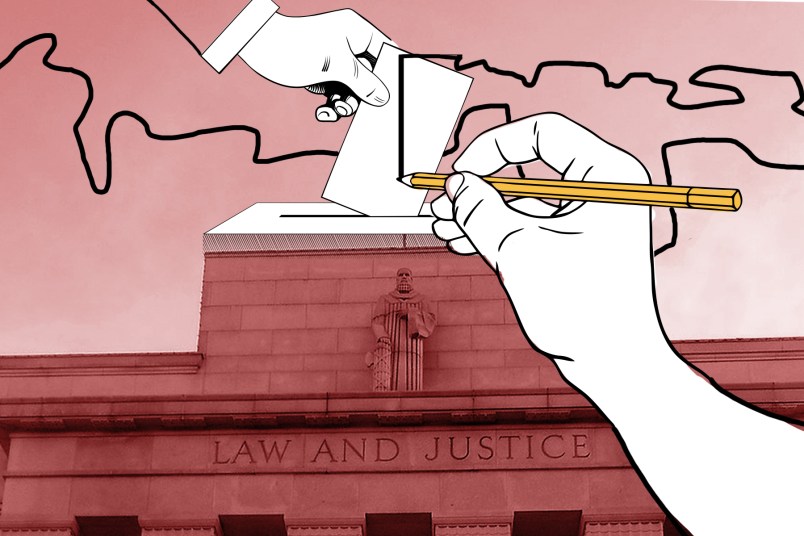Just over a year ago, the North Carolina Supreme Court struck down the congressional and legislative maps Republican state lawmakers had produced, calling them “unconstitutional beyond a reasonable doubt.” The dispute eventually made its way to the U.S. Supreme Court, and was argued in December 2022.
But on Tuesday, the North Carolina Supreme Court heard the same case — again. None of the underlying facts of the case — the evidence examined rigorously by a panel of judges, that decision reviewed and overturned by the state Supreme Court — have changed. But the court has. The 2022 election cycle shifted the balance of power on the state Supreme Court, giving the right-wing judges a lopsided, 5-to-2 advantage.
Sensing opportunity, the Republican lawmakers took a chance that the judges’ partisan allegiance would trump the unprecedented silliness and naked political calculation of a court rehearing a case it just heard months before. Their gamble paid off.
The North Carolina Supreme Court is now reconsidering the same case it decided last year, while the U.S. Supreme Court tries to figure out what to do with Moore v. Harper, the case that grew out of the state-level dispute. Currently, the U.S. Supreme Court is waiting for briefing on how the state court’s decision to rehear the case affects its role in the proceedings. If the state court reverses its decision, as expected, much of the Supreme Court’s case would seem to be moot.
But there’s a wrinkle. The reason the U.S. Supreme Court case garnered so much attention is because it has ramifications beyond the already significant effects of a garden variety gerrymandering dispute. Lawyers for the North Carolina legislators premised some of their argument on the independent state legislature theory, a contorted reading of the U.S. constitution that would give state legislatures — to the exclusion of state courts, state constitutions and governors — the sole power to govern federal elections.
At Tuesday’s state court oral arguments, Phillip Strach, a management-side labor lawyer representing the state legislature’s Republicans, didn’t concern himself with the ISLT. He focused on urging the justices to overturn last year’s decision, insisting that the Supreme Court’s involvement does not remove their jurisdiction.
“This court certainly has the authority to overrule Harper 1, notwithstanding Moore v. Harper,” Strach said, referring to the February 2022 decision striking down the legislature’s maps.
The Democrats on the bench, who’d angrily dissented from the majority’s decision to rehear the case, pressed Strach. At points, it seemed they were laying the groundwork for another coming dissent.
Justice Anita Earls pointed out that the Republican lawmakers are not asking the justices to determine that underlying facts in the old case were “wrongly found.”
“They were among the most extreme gerrymanders possible and were carefully crafted for Republican advantage, more so than 99.999 percent of possible congressional maps, 99.9 percent of possible Senate maps and 99.9999 percent of possible House maps,” she said, adding: “So you’re asking us to say that, in spite of those facts, the North Carolina constitution offers no protection to voters?”
Strach answered in the affirmative, asserting that the state constitution does not protect against partisan gerrymandering. The Supreme Court closed the federal courthouse doors to partisan gerrymandering claims in 2019’s Rucho v. Common Cause, but said such cases could still be litigated on the state level. North Carolina lawmakers are trying to shut down that route too.
Justice Michael Morgan, the other Democrat, jumped in, asking whether an election could be considered “fair” as required by the Constitution if it was predetermined by where the legislature drew the lines.
“Elections in North Carolina are fair and they are well run — that has nothing to do with redistricting, that has nothing to do with partisan gerrymandering,” Strach claimed.
Still, if there was any chance that the right-wing justices would be shamed into steering away from reversing themselves so quickly, it was not apparent Tuesday.
Chief Justice Paul Newby engaged in an extended hypothetical about whether it’s “suspect” to have smaller bodies of governance, like school boards, be dominated by members of one party. He then leaned into allusions to the partisan unsavoriness of the experts who helped the courts determine that the legislators’ maps were extreme gerrymanders. Lali Madduri, a lawyer for the plaintiffs, responded that the courts had investigated those accusations of partisan taint, and found that they did not affect the evidence.
The newly elected Justice Richard Dietz went even further afield, using up many minutes of the voting groups’ time to ask the other lawyer for the plaintiffs, Sam Hirsch, to defend an amici — not his client — who’d called the Republican legislators’ lawsuit “frivolous” in a filing.
After Hirsch finally wrenched back his time to continue making his argument, Dietz jumped in again during the rebuttal to ask about the questions around jurisdiction with the U.S. Supreme Court’s involvement. Hirsch tersely said that he’d be filing a brief with the U.S. Supreme Court by March 20 and tried to return to his argument.
“I’m a justice on the Supreme Court of North Carolina, we’re hearing this case, so I’m asking you for your legal view,” Dietz broke in, putting his hand on his chest for emphasis.
Hirsch evaded the question and returned to his argument, winning a grudging 10 seconds back from the chief justice to finish.
The two cases, one at the state court and one at the U.S. Supreme Court, will now proceed on parallel tracks. While it seems likely that the North Carolina court will reverse itself and allow state Republicans to gerrymander with impunity, more uncertainty clouds the Supreme Court’s path. Many of the justices have expressed support of the ISLT and eagerness to hand down a ruling on it — if they’re hungry enough to take that opportunity now, they could forge on with that part of the case, leaving the maps to the state.



